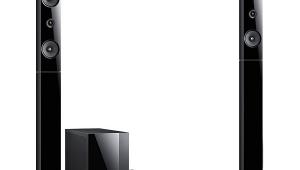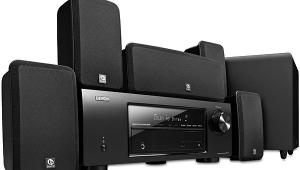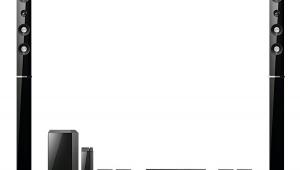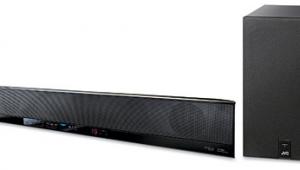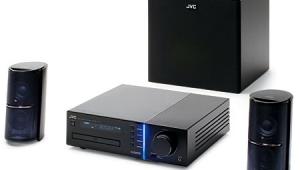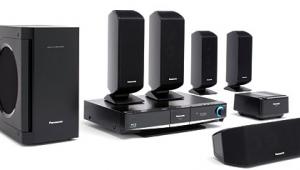JVC EX-A10 Compact Component System
There's something unusual, novel, even peculiar about this compact system. But I'm not going to tell you what it is yet. Instead, I'll tell you what I think is most significant. The JVC EX-A10 takes me back in time, back to when I was a kid, before everything went digital. I used to carefully clean my records, put them on the turntable, flip sides every 20 minutes, and play music for hours upon hours. This JVC system has that old-time analog feel.
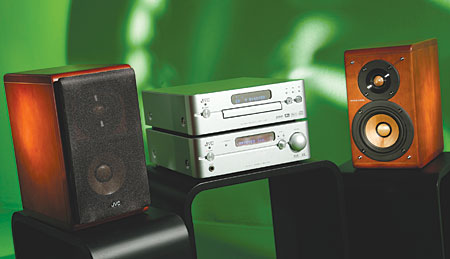
Now for the unusual, novel, even peculiar part: The two speakers have diaphragms made of wood. Their solid, cherry wood enclosures make a good first impression. Pull off the grilles, and you'll see drivers made from thin sheets of pressed birch. The EX-A10 is a two-way design with a woofer and a tweeter.
JVC had two rationales for heading down this less-trodden path. The technical explanation has to do with the way wood affects wave propagation and attenuation compared with conventional metal, plastic, and paper drivers. The other reason is more immediately intuitive—if wood sounds good in violins, cellos, and guitars, why not try it in speaker diaphragms?
Toshikatsu Kuwahata of JVC spent 20 years refining the manufacturing process. It must have been a lonely quest. His biggest problem was the brittleness of the thin wooden sheets. The big breakthrough came when he realized that soaking the sheets in sake (Japanese rice wine) would make them pliable enough to stamp them without cracking.
That alone makes an interesting story. But what hooked me on this system was the way it ties into a bunch of other trends that have crossed my desk. More than two decades after the CD's debut, a retro audio rebellion is in full swing. Of course, there are the folks (myself included) who hung onto their vinyl. And then there are those kids in Britain who prefer 45-rpm records to CD singles. But plenty of other people are also doing something, anything, to make their iPods sound better, even if it means plugging them into tube amps. Mark Levinson, one of high-end audio's founding fathers, swears that the Burwen Bobcat's computerized enhancement of compressed file formats represents "the end of the digital nightmare." The list goes on.
If you're ready to resort to diamond styli, vacuum tubes, or psychoacoustic magic, why not try a little pressed birch? The EX-A10 really whipped me back through the paisley corridors of time to when occasional surface noise was a bigger problem than perpetual quantizing noise and listening to music was profoundly relaxing. I'm not suggesting that this system makes digital signals sound just like analog. But it left me with a similar feeling. And it's the feeling that counts.
Now There Are Two Drivers Knocking at the Door
JVC's first wood-driver system was a desktop system with only one driver per speaker enclosure. It had a nice warm sound but, at the time, seemed little more than a novelty. The EX-A10 is a more serious music machine, with two-way speakers and the addition of a wood-dome tweeter to the wood-cone woofer. It also aspires to home-theaterdom with a supplied DVD player.
The system also includes a compact receiver. JVC refers to it as an integrated amplifier, although it does include an AM/FM tuner. There are only two speakers and no subwoofer. The amp has a sub output but no crossover settings, so you'll have to handle that with the sub's controls. A synchro cable coordinates the operation of the amp and the player—when you power down the receiver, the player goes into standby, as well.
Video outputs are analog only, including component video, with no HDMI. For external audio sources, the amp accepts two optical digital inputs and two stereo analog inputs. I used one optical input for JVC's DVD player and one analog in for my PC. The player can read Dolby Digital and DTS soundtracks and downmixes them to stereo.
Plastic front panels curve at the sides and present few controls to challenge the user. The amp has a bulbous volume knob, a small source-select knob, a headphone jack, and three buttons so small they almost disappear: Search +, Search –, and CC Converter. The disc player has two large transport controls (eject, play/pause) and three more almost invisible ones (stop, track +, and track –), in addition to the disc drawer.
The CC Converter uses proprietary algorithms to increase quantization resolution for low-level signals and the sampling frequency for high-frequency signals. It converts a 16-bit, 44.1-kilohertz CD, for example, to a 24-bit, 176.4-kHz signal before converting it to analog. The CC Converter also works with compressed motion-picture formats like Dolby Digital and DTS. I liked the way the circuit affected treble frequencies, and I left it permanently engaged.
I set up the system on my desk, since it fit there rather well, and played audio files while multitasking. At first, I didn't get it. The system seemed a little bland but not unpleasant. My brain didn't wave the red flag that says, "Ow, turn it down." So, I turned it up to hear the sound better. It felt good, so I turned it up again. And again. And then I knew I was onto something special—something, well, different.
What I didn't hear was noteworthy. It reminded me of Silver Blaze, a Sherlock Holmes story in which the detective solves a mystery by noting that a guard dog didn't bark. What I wasn't hearing was the sonic signature of a ringing metal tweeter. The overall effect was one that I normally associate with vinyl. But everything I played during this getting-to-know-you process was MP3.
 Typical sounding was Fiona Apple's Extraordinary Machine (MP3, 192 kilobits per second). Her quirky, quavering voice emerged silky and clean. It was slightly in the forefront of the soundstage, with the whimsical orchestral arrangements slightly behind, although the depth between them was minimal. The leading edge of the midrange was not hard or artificial but smooth and natural. Treble was not especially airy or extended, but it integrated with the midrange into a seamless whole. A warm coloration, the sonic equivalent of a sepia tint, lay over everything. It was gentle and agreeable.
Typical sounding was Fiona Apple's Extraordinary Machine (MP3, 192 kilobits per second). Her quirky, quavering voice emerged silky and clean. It was slightly in the forefront of the soundstage, with the whimsical orchestral arrangements slightly behind, although the depth between them was minimal. The leading edge of the midrange was not hard or artificial but smooth and natural. Treble was not especially airy or extended, but it integrated with the midrange into a seamless whole. A warm coloration, the sonic equivalent of a sepia tint, lay over everything. It was gentle and agreeable.
Moooo
When I moved the system into my main listening position and began playing uncompressed music, all of the impressions above held firm. But something else entered into the listening experience. Suddenly, I had an uncanny feeling that I was looking into the music. There was depth, vivid instrumental color, texture, focus, and realism. It's a feeling I associate with bleeding-edge gear and was the last thing I expected from a mass-marketed compact system.
A minute of barnyard noises kicks off Round-Up, a winning collection of Western movie soundtracks by the Cincinnati Pops with Erich Kunzel. I could play only the CD layer of the SACD hybrid. Even so, the bellowing moo of cattle practically knocked me out of my office chair. The first musical selection is the "William Tell Overture." The string sound was beautifully refined, surprisingly so for a CD, and just a little sweet, the way I like it. I was surprised by the crispness of the cymbals and the ringing of the triangles. The MP3s I'd been playing up to this point led me to incorrectly peg the tweeter as reticent. It had more definition than I expected, although it still maintained its natural, relaxed character. There was a newfound openness, as well—I could hear the roomy ambience of the concert hall.
The interaction of instrument and space also came to the fore with Gabriela Montero's performance of Rachmaninoff's "Moment Musical in E Minor" from her Piano Recital CD. On my reference system, the piano is more prominent than the space, but the EX-A10 reversed that relationship and gave the upper registers a glassine quality that I hadn't heard before. This audition also emphasized the system's one serious deficiency—bass was present but lightweight, despite Montero's powerful left hand. The time had come to move the system to my reference listening position and connect my Pinnacle Baby Boomer sub.
I don't mention it often, but I listen to a lot of Chinese music with twangy traditional instruments. The best recorded of these CDs gave me the impression that the violin-like erhu, the hammered-dulcimer-like yangqin, and other instruments were right there between the speakers. The system also excelled with Western chamber music, delicately rendering the texture and spacing of violins and cellos. The midrange was fully fleshed out but not artificially outlined. Treble was extended but not edgy. I was amazed.
Among the system's few serious sonic limitations is dynamics. With high-decibel rock'n'roll, like the Fall's The Complete John Peel Sessions 1978–2004, the system didn't exactly go screechy at high volumes. But its vivid tonal colors went monochromatic, and the soundstage lost some definition. JVC insists that the wooden drivers break up minimally and differently than other driver materials. I'd guess I was hearing the limits of the miniaturized Class D amps. And, no, you can't use these speakers with another amp—JVC says that would damage them. Since they are biamplified and have no internal passive crossovers, these speakers are forever mated solely to their matching four-channel stereo amplifier.
So, this is not a rock-'n'-roll system. Nor is it an action-movie system, especially given the lack of surround channels. But it is the best two-channel desktop system I've heard in years, and, for classical and jazz listeners, it can dominate a medium-sized room with a compelling soundstage. I still can't get over how it reawakened sensations I hadn't had in decades. Oddly enough, though, for the entire time, I didn't feel the need to play vinyl. The feeling this system engendered was enough.
Highlights
• Pressed-birch drivers
• Has separate amplifier and disc player
• Extremely involving sound
- Log in or register to post comments
